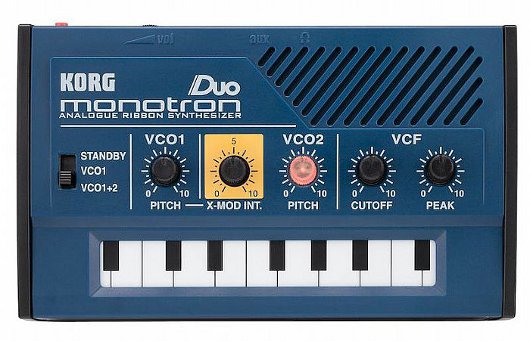Korg Monotron Duo review

Continuing their new found love affair with all things small and analogue, the legendary Korg MS20 filters are born again in the shape of the Monotron Duo.
The Duo is a member of the Monotron family of micro analogue ribbon synthesizers from Korg. The main features are the two oscillators, along with Korg’s signature filters. The three main Montron synths are all a palm-sized 120mm x 72mm x 28 mm and weigh in at a feather-like, 95 grams, very much in line with Korg’s “go anywhere analogue” concept, which is cunningly ambiguous; apart from the obvious portability benefits, this statement hints at the versatility crammed into these small machines. If you’re unfamiliar with this series, there are three different versions of Korg’s micro ribbon synth – next to the original Monotron are the Monotron Delay (featured here last month), and the Monotron Duo, which is our focus this time.

For those familiar with the original Monotron, the Duo has some similarities. It has five control knobs on the front panel and the all important ribbon control strip itself. It has an integrated speaker built in and a three mode sliding switch. On the back is simple volume control, a 1/8” headphone output, a 1/8” auxiliary input jack and a curious red button which allows the user to toggle between different scale modes on the ribbon strip itself. There are four scale modes; a full chromatic, a major scale, a minor scale and a continuous mode, which are useful for getting some interesting quarter tones into your sound. However, the main attraction of this unit has to be the dual oscillators. The switch at the front offers single oscillator mode, two oscillator mode (hence the name), and standby mode. Next to this is the pitch control knob for oscillator one, which has a satisfyingly large range. If you want to add some edge to your sound then turn the x-modulation knob, with the pitch for Oscillator Two sitting at the end of the oscillator section. The last two knobs control the cut off and peak of the famous Korg filter. The tone generated is that of a very full and rich square wave.
One of the things that strikes you about this synth is the fullness of the tone; the single oscillator alone produces a meaty sound that can make the filters really scream, and its rich depth belies its diminutive stature. The technical workings of x-modulation and how it works in single oscillator mode are complex but it only takes a little bit of playing around before the Duo starts making some truly remarkable and inspiring sounds. In two oscillator mode you can come up with some great classic mono lead sounds; pitch one of the oscillators up or down to create warm fifths, or take a subtler approach by dabbling in pulsing, throbbing vibrato like tones. You can plug other sound sources into this unit via the auxiliary input at the back, allowing the user access to the famous filters.

Although the products in the Monotron series look like toys, they have the weight of a powerful legacy behind them. There are other ribbon synths on the market, of course; the famous Stylophone brand are still introducing new products and there is a mini ribbon controller by Gakken too. But despite its noisy output signal and AAA battery power, Korg are reintroducing their analogue heritage into a digital age and it’s more than welcome. Will they go the whole hog and give us a new analogue keyboard to go along with their ribbon synths in the future? We’ll have to wait and see.
Specifications:
Dimensions 120mm x 72mm x 28mm
Weight 95 grams
Power 2 x AAA batteries (around 8 hours usage)
Controls: VCO1 pitch, VCO2 pitch, x-modulation, filter cut off, filter peak. Wide range ribbon control. Standby, VCO1 and VCO1+2 selection. Volume control. Scale toggle button.
Connections: 1 x 1/8” headphone jack, 1 x 1/8” auxiliary input
| Dimensions | 120mm x 72mm x 28mm |
| Weight | 95 grams |
| Power | 2 x AAA batteries (around 8 hours usage) |
| Controls: | VCO1 pitch, VCO2 pitch, x-modulation, filter cut off, filter peak. Wide range ribbon control. Standby, VCO1 and VCO1+2 selection. Volume control. Scale toggle button. |
| Connections: | 1 x 1/8” headphone jack, 1 x 1/8” auxiliary input |